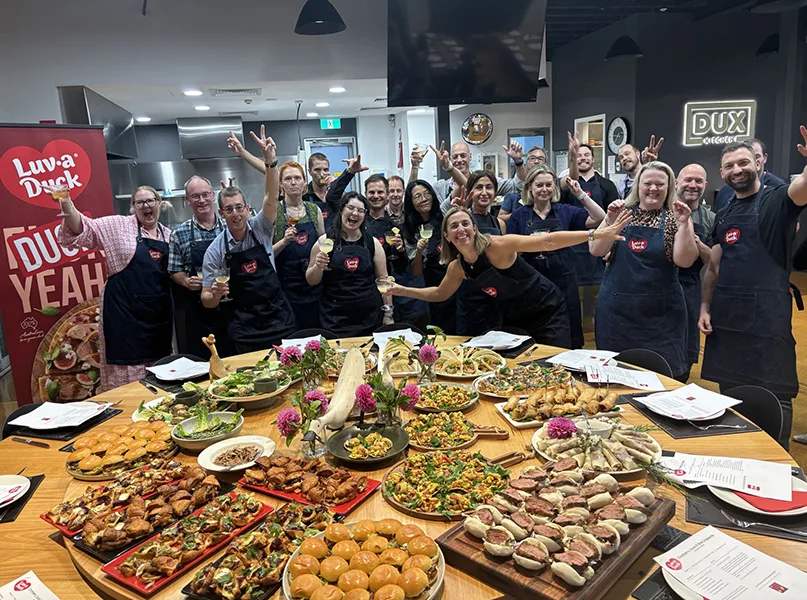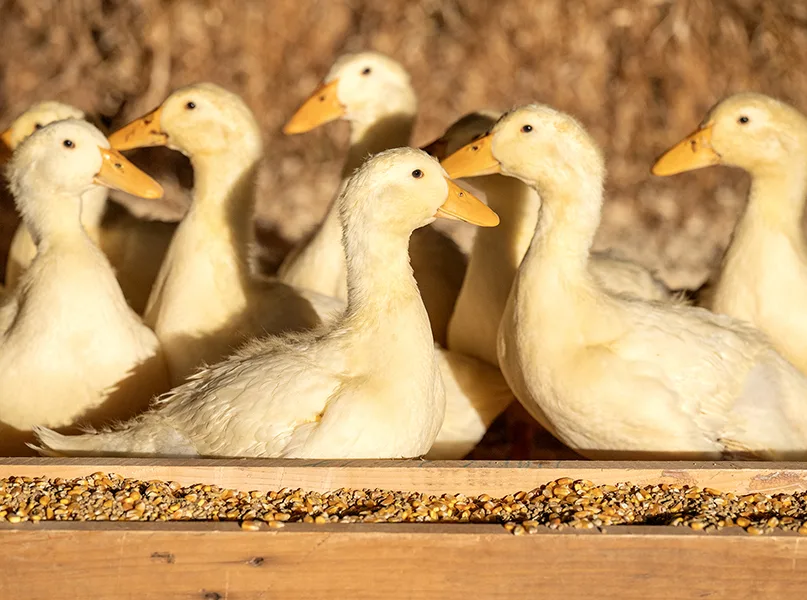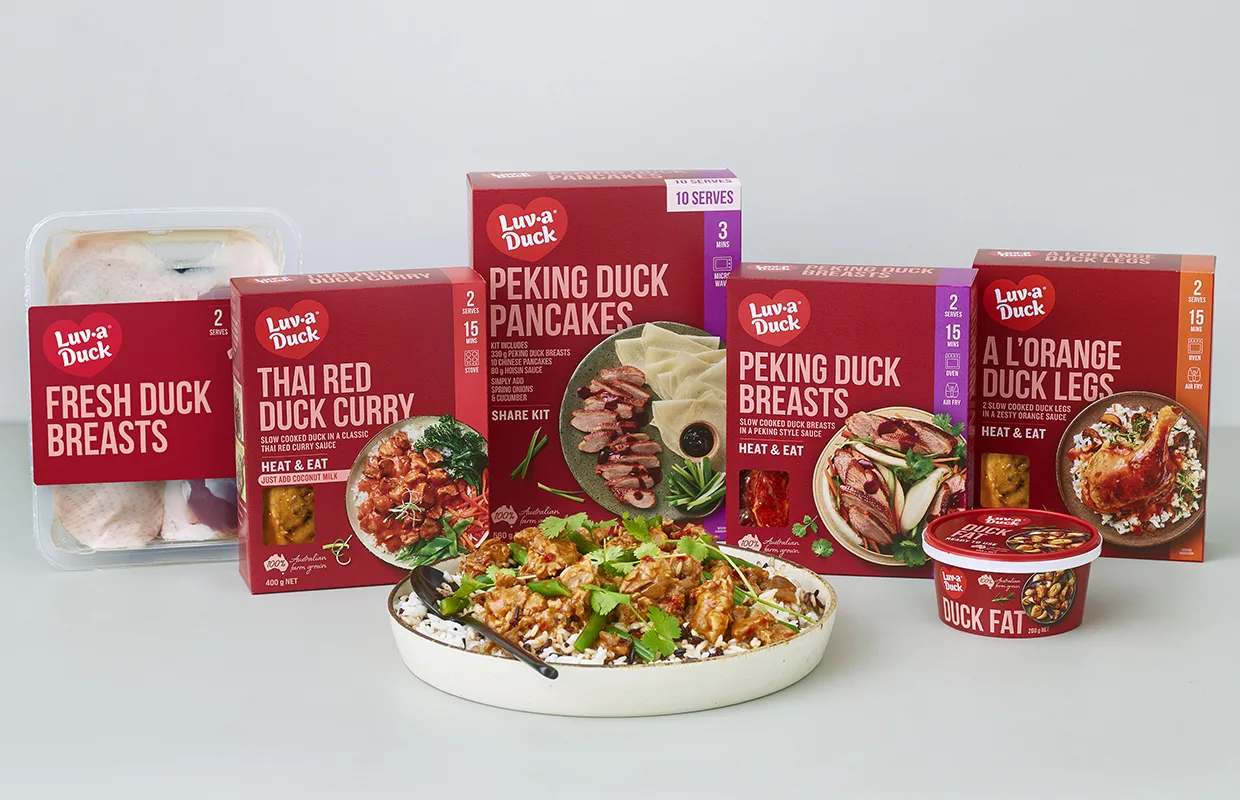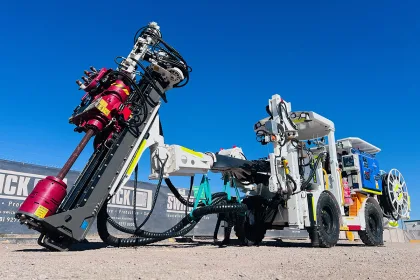Encouraging consumers to explore and embrace the versatility of duck meat, Luv-a-Duck’s farm-to-fork products offer a succulent meal, elevating cuisine in Australia and beyond. CEO, Daniel Shoppee, discusses his family’s culinary legacy and heritage.
DUCK YEAH!
The duck farming industry is beginning to take flight in Australia as a delicious protein option, reflecting the country’s diverse agricultural landscape and cultural influences.
A good source of protein with twice the iron of beef, duck is a great source of several key amino acids and magnesium, which are essential for muscle repair, growth and bone health – yet it is not as commonly consumed as other staple meats.
One company on a mission to promote it as a popular choice in restaurants, homes, and retail is Luv-a-Duck.
Carving a niche in Australia’s culinary realm, Luv-a-Duck’s products are ethically reared and proudly produced with a focus on showcasing the potential of duck meat and inspiring food enthusiasts – whether a home cook or professional chef – to incorporate this nutritious and delicious product into their everyday cooking routines.
Luv-a-Duck is a family business with a catchy and enjoyable name that originated from the company’s founder, Art, the grandfather of current CEO, Daniel Shoppee. Established in 1968, the business started in the small town of Nhill in the state of Victoria (VIC).
Notably, Art had no prior experience in the industry when he transitioned from owning a dry-cleaning business to producing ducks.
“Nhill is an isolated place, but that’s where we started and have remained ever since. The company was founded on a challenge when my grandfather and his best friend returned from a trip to Melbourne with 20 ducks each and raised them in their backyards. Whoever could grow the biggest and best birds would win!” Shoppee smiles.
Art firmly believed providing birds with high-quality feed, rather than kitchen scraps, was the key to winning the bet, and this principle continues to be a guiding mantra for the company today.
“We are what we eat. The same goes for ducks.”

DUCK DOWN UNDER
In the food service industry, duck is recognised for its plump, juicy meat and premium taste, which the Shoppee family has long understood.
However, it has not yet achieved the same level of popularity as more common meats in Australia.
“The consumption of duck meat is around 300 grams per person, per annum, whereas chicken is 50 kilogrammes (kg) – that’s a huge disparity. We aim to make it more approachable and easier to use,” Shoppee informs.
“People shouldn’t be scared of duck meat; it is special and there to be enjoyed. This is what my grandfather came to realise when he pivoted away from a career in the foodservice sector and ended up introducing a whole range of precooked duck portions and flavours.”
This was a turning point in the Luv-a-Duck story as the company entered the retail sector, marking a significant milestone and a new era.
As a family-owned business, its heritage has been passed down through the generations and continues today with Shoppee’s mother and aunt at the helm.
“Having two females in leadership roles in both a manufacturing and farming business is quite unique. I joined the company straight out of high school and worked through various divisions before becoming CEO. Now, I am dedicated to taking Luv-a-Duck to the next stage of its development,” he shares.

A QUACKING NEW FACILITY
As a vertically integrated operation, Luv-a-Duck maintains complete control over the entire supply chain, ensuring the quality of its products from breeding to hatching and primary processing.
“Our complete livestock division is based in Nhill, with a new facility in Ballarat, which we opened in 2021. We remain committed to being regional as it is part of our history and identity,” Shoppee prides.
The value-added plant in Ballarat has positively impacted Luv-a-Duck’s offerings, with the purpose being to create a retail product range that is convenient, easy to use, and high-quality.
“We previously relied on a manual process that, whilst effective, was labour-intensive. To enhance our operations, we opened a new facility and expanded into the retail space, making our products appealing and accessible to a wider audience.
“We invested significantly in technology, upgraded our cooking processes, and implemented new automation for flavouring and portioning. These changes have dramatically transformed our business.”
Luv-a-Duck’s decision to launch an entirely new product line has proven successful, as no other company in the country offers precooked duck portions. Australians are starting to acquire a taste for ‘home-cooked’ duck in this new pack format, and the demand is growing for new flavours and product innovation.
Furthermore, with more than five million ducks produced yearly, the company can maintain quality control throughout the supply chain thanks to its vertical integration.
“From start to end, everyone works in quality control teams under one umbrella. That is one of the unique advantages of being vertically integrated; it is absolutely critical to maintain control,” Shoppee expresses.
“To promote the Luv-a-Duck brand effectively, it is essential to trust in the quality of our products. We must consistently uphold high standards throughout every stage, from raising the ducks to primary processing and packaging. We remain committed to these steps without compromise.”

“To promote the Luv-a-Duck brand effectively, it is essential to trust in the quality of our products. We must consistently uphold high standards throughout every stage, from raising the ducks to primary processing and packaging”
Daniel Shoppee, CEO, Luv-a-Duck
REDEFINING GOURMET DINING
Luv-a-Duck focuses on specific products to meet consumer preferences by offering ranges to suit any skill of entertainer or home chef, including Peking duck breast, confit duck legs, duck à l’orange, and Chinese pancake kits.
“We’re developing the next range of convenience with frequent releases. We have our red duck curry, which is deboned, cooked, and flavoured. The next layer is bao buns, spring rolls, dumplings, and the like. There will be products for every occasion, from BBQs and festive seasons to dinner parties,” Shoppee excites.
One of the reasons Luv-a-Duck has expanded into a fully cooked range is that many people are unsure how to prepare a meal with duck.
The company aims to eliminate this concern, allowing consumers to enjoy duck without worrying about complicated cooking processes.
Branding is crucial for Luv-a-Duck, especially in Australia, where duck consumption per capita is low. Therefore, strategies need to be put in place to raise consumer awareness.
“We are still a small business with a limited marketing budget, so to capture people’s attention, we have employed some clever wordplay in our latest advertising campaigns. Whilst our approach is a bit cheeky, our brand has a strong presence and resonates amongst retailers and consumers in Australia,” he enthuses.
“We don’t take ourselves too seriously, nor should our marketing. We enjoy having fun with it, and the team culture aligns with this approach. Our strategy is to get noticed on a small budget.”
The campaign is showing positive results as duck consumption in Australia is increasing.
“People often compare duck to chicken, but in reality, it should be compared to beef or lamb, which are both red meats. Duck will never be just another low-cost commodity; instead, we want it to be valued alongside premium cuts like beef ribeye and lamb leg – this is where duck deserves to be,” acknowledges Shoppee.
“The ultimate goal is to encourage people to try this amazing product. My family and I enjoy it. It’s a delicious and fantastic source of protein”
Daniel Shoppee, CEO, Luv-a-Duck


EDUCATE TO ELEVATE
Regarding the ongoing Luv-a-Duck legacy, the company is expanding its operations and targeting specific markets for potential product exports.
“We recently attended the FHA-Food & Beverage 2025 trade event in Singapore, as the Southeast Asian region is becoming increasingly important for us. Some people thought I was being overly ambitious by trying to sell Australian duck in the Asian market, but the brand is well-recognised, and the quality is outstanding,” Shoppee assures.
“The Wimmera district in VIC upholds the highest biosecurity standards, and we are the only operators in the area with no biosecurity issues encountered. Our high-quality products and strict biosecurity measures are in demand in Southeast Asia, particularly amongst upscale resorts and restaurants that appreciate a compelling provenance story.”
Additionally, Luv-a-Duck operates a cooking school in Melbourne, which serves as an education hub to further encourage consumers to embrace duck.
“We offer a variety of classes, totalling about seven each week, where we teach participants how to prepare a wide range of duck dishes. During the two to three-hour sessions, participants can enjoy wine and taste what they have made. Our goal is for them to feel confident enough to recreate these dishes at home.”
Recognising the importance of educating consumers on how to mitigate duck disasters in the kitchen is aided by the company’s most significant investment to date.
The new value-added plant in Ballarat, equipped with cutting-edge technology to enhance the duck consumption experience, has proven successful in this regard, yielding high-quality products that can be easily cooked and enjoyed at home. All consumers need is an air fryer to achieve restaurant-quality duck.
“Outside of China and Southeast Asia, duck consumption globally is limited. We aim to increase its visibility with our branding and marketing, centred on capturing the public’s attention,” he emphasises.
In the upcoming year, Luv-a-Duck’s main priorities are focused on expanding the business and increasing duck consumption to 1kg per person, per year. The aim? To “Duck Every Dish”.
“The ultimate goal is to encourage people to try this amazing product. My family and I enjoy it. It’s a delicious and fantastic source of protein,” Shoppee optimistically concludes.






































